牛津译林 模块六第三单元 M6U3 Welcome to the unit
- 格式:ppt
- 大小:2.70 MB
- 文档页数:21
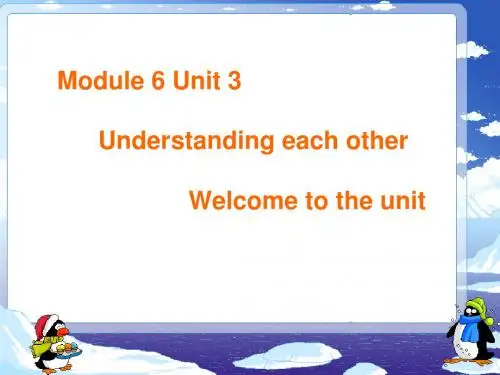
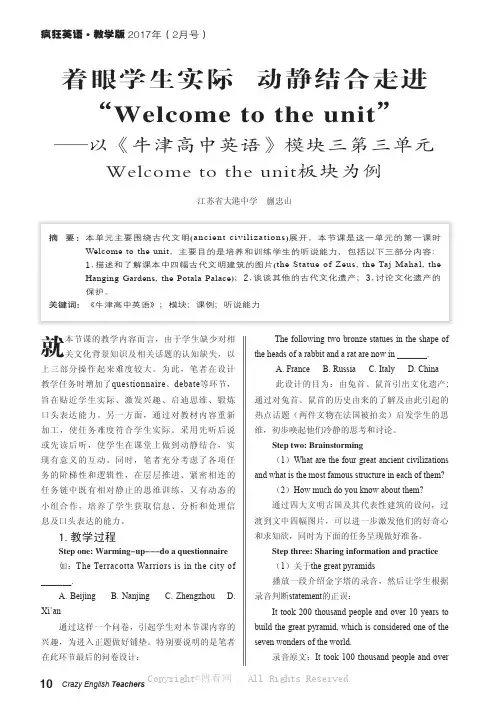
疯狂英语·教学版2017年(2月号)摘 要:本单元主要围绕古代文明(ancient civilizations)展开。
本节课是这一单元的第一课时Welcome to the unit。
主要目的是培养和训练学生的听说能力,包括以下三部分内容:1.描述和了解课本中四幅古代文明建筑的图片(the Statue of Zeus, the Taj Mahal, theHanging Gardens, the Potala Palace);2.谈谈其他的古代文化遗产;3.讨论文化遗产的保护。
关键词:《牛津高中英语》;模块;课例;听说能力江苏省大港中学 蒯忠山就本节课的教学内容而言,由于学生缺少对相关文化背景知识及相关话题的认知缺失,以上三部分操作起来难度较大。
为此,笔者在设计教学任务时增加了questionnaire、debate等环节,旨在贴近学生实际、激发兴趣、启迪思维、锻炼口头表达能力。
另一方面,通过对教材内容重新加工,使任务难度符合学生实际。
采用先听后说或先读后听,使学生在课堂上做到动静结合,实现有意义的互动。
同时,笔者充分考虑了各项任务的阶梯性和逻辑性,在层层推进、紧密相连的任务链中既有相对静止的思维训练,又有动态的小组合作,培养了学生获取信息、分析和处理信息及口头表达的能力。
1.教学过程Step one: Warming-up---do a questionnaire如:The Terracotta Warriors is in the city of _______.A. BeijingB. NanjingC. ZhengzhouD. Xi’an通过这样一个问卷,引起学生对本节课内容的兴趣,为进入正题做好铺垫。
特别要说明的是笔者在此环节最后的问卷设计:The following two bronze statues in the shape of the heads of a rabbit and a rat are now in _______.A. FranceB. RussiaC. ItalyD. China此设计的目为:由兔首、鼠首引出文化遗产; 通过对兔首、鼠首的历史由来的了解及由此引起的热点话题(两件文物在法国被拍卖)启发学生的思维,初步唤起他们冷静的思考和讨论。


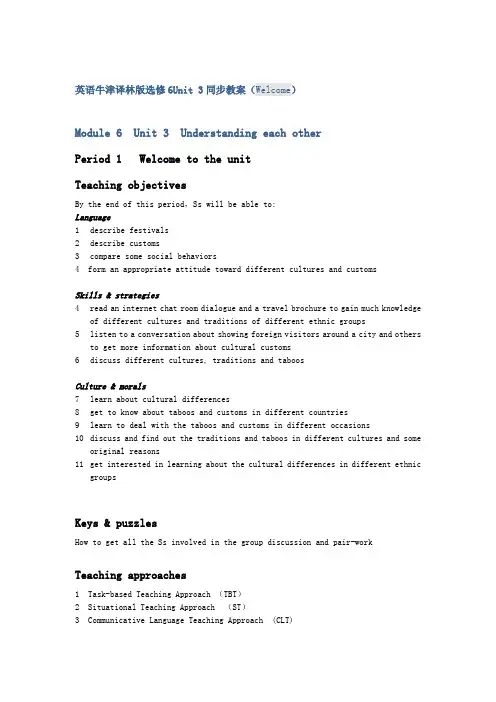
英语牛津译林版选修6Unit 3同步教案(Welcome)Module 6 Unit 3 Understanding each otherPeriod 1 Welcome to the unitTeaching objectivesBy the end of this period,Ss will be able to:Language1describe festivals2describe customs3compare some social behaviors4 form an appropriate attitude toward different cultures and customsSkills & strategies4read an internet chat room dialogue and a travel brochure to gain much knowledge of different cultures and traditions of different ethnic groups5listen to a conversation about showing foreign visitors around a city and others to get more information about cultural customs6discuss different cultures, traditions and taboosCulture & morals7learn about cultural differences8get to know about taboos and customs in different countries9learn to deal with the taboos and customs in different occasions10discuss and find out the traditions and taboos in different cultures and some original reasons11get interested in learning about the cultural differences in different ethnic groupsKeys & puzzlesHow to get all the Ss involved in the group discussion and pair-workTeaching approaches1 Task-based Teaching Approach (TBT)2 Situational Teaching Approach (ST)3 Communicative Language Teaching Approach (CLT)Teaching aidsa multimedia courseware and a blackboardTeaching proceduresIn generalIn Welcome to the unit, six pictures and three questions are all Ss can access to in the textbook. However, Ss are supposed to do a lot of talking and discussing about pe ople’s different ways of greeting each other in different countries and compare some different daily behaviors and different festivals of the east and the west by gaining some information shown through multimedia.First, two Ss, as the duty reporters, give a performance about different Chinese people’s greetings to different people, such as their superiors and their peers, and by asking Ss to guess and give explanations, the teacher will lead into the different greetings in different countries shown in the six pictures and add something about the pictures. In order to stimulate the Ss’ interest, the teacher designs a humourous story about ‘cultural shock’, brainstorm the Ss and discuss how to avoid this phenomenon together. After their discussion and expressing their own opinions about the possible problems that might be caused by these differences, the Ss are expected to take part in the discussion about table manners and further think on the topic why more and more foreigners are learning how to use chopsticks. Apart from delicious Chinese food, they also like China not only because of its beautiful scenery, especially so many World Heritages of nature and culture, but its rich and colorful cultures and customs. The teacher can try to elicit more, arousing t he Ss’s patriotism. Next the Ss are to look at some pictures and gain some information about Halloween and Qingming Festival through multimedia, and after discussion, the Ss are supposed to get the general idea of cultural differences.Then the Ss are asked to have a competition on the topic of Chinese young people’s craze about celebrating Christmas Day. Through heated argument they are expected to form an appropriate attitude towards different cultures and customs. At last, Ss are ask to summarize the main contents and consolidate the new words and expressions about cultures and customs in this period. At the end of the period, Ss are encouraged to choose one of the three topics they have discussed to write a composition according to the results they’ve go t. In a word, the whole lesson is a big discussion involving all the Ss brainstorming, discussing in groups or pairs, and competing, which will hopefully pave the way for the learning in the section of Reading.(通过同学表演审视自己平时的交际(问候)方式→设计关于‘文化休克’的风趣小故事,让学生进一步了解东西方不同文化背景下的见面问候方式的不同→思考并讨论怎样对待这些不同的方式→讨论东西方不同的餐桌礼仪→了解并比较西方的万圣节和中国的清明节→就中国许多年轻人热衷于过圣诞节开展辩论赛→通过图片展示和归纳总结本次课所接触的新鲜词汇和表达方式→布置作业)In detailStep 1 Warming up (5 minutes)1. Have two Ss, as the duty reporters to give a performance about different Chinesepeople’s greetings to different people, such as their superiors and their peers and ask their classmates to guess and give explanations. (3 minutes)2. The teacher gives a humourous story about ‘cultural shock’ to stimulate theSs’ interest, brain storm the Ss and discuss how to avoid this phenomenon together.(3 minutes)3. The teacher can try to elicit more. For example, just as the two Ss performed,if we meet a friend in the street, we often say: “Hi, have you had your meal”or “Where are you going”. When it is the case of two gentlemen, they tend to shake hands. However, in western countries, the above questions are just questions, not greeting at all. They may think you’re inviting them to dinner if you ask about their meals. Usually, they’ll j ust give each other a smile or greet with a “Hi.”. They’ll shake hands only in some formal situations. By the way, Westerners can leave a party or meeting halls without a formal conge, nor should they shake hands with every attendee like most of us will do here.Now let’s see some other foreigners greet each other. ( 2 minutes)(See courseware)Step 2 Discussion (15 minutes)1. Ask Ss to talk about the six pictures and require them to try to remember these different greetings and the teacher can add more. (3 minutes)2. Then have the first group discussion about If someone greets you in these ways what will you do then (3 minutes)3. The teacher can guide the Ss to our state leaders’ different ways of greeting their different heads while visiting different countries, making the Ss get to understand and form appropriate ideas and ways to communicate with different people in different cultures and customs. Remember this saying(write down on the Bb):Do in Rome as the Romans do. And ask the Ss to form a habit of taking notes while discussing and write a composition about the result of the discussion afterclass. (1 minute)Write down the title on the Bb An appropriate attitude to different greetings4. Then Ss share their ideas and the teacher gives assessment. (3 minutes)5. Now, come to the section of table manners by showing some pictures.(see courseware) If the Ss don’t know how to use a knife and fork, the teacher will tell them: when westerners eat, their bowls and plates cannot leave the table. Food should be cut by knife to fit into the mouths. Of course your mouth cannot touch the plates or bowls. So the regular process is like this. You cut your steak on the plate with a knife and fork and send the meat cube into the mouth with the fork and nothing will be returned but the fork alone. (2 minutes)6. Then discuss in pairs Why more and more foreigners are learning how to use chopsticks and what it implies. (2 minutes) Then the Ss give their opinions and the teacher will give proper assessment and add something necessary, like this: foreigners not only like Chinese delicious and healthy food but also its splendid national culture, and they even like China not only because of its beautiful scenery, including so many world heritages of nature and culture, but also its higher and higher international standing, arousing the Ss’ sense of taking pride in our motherland. (4 minutes)Write down the title on the Bb: Why foreigners long to learn to use chopsticks Step 3 Further Discussion (10 minutes)1. Cultural differences exist not only in daily life but in some traditional festivals. Ss will look at some pictures(see courseware)to learn about Halloween in the West and Chinese Qingming Festival. When showing pictures the teacher will remind Ss to take care not to cause forest fire if they go grave-sweeping, burning joss sticks and fireworks.(5 minutes)2. Then group work for discussion. Ss are to choose one or two to prepare from the following questions(see courseware),then share their opinions. The teacher will give some help and his own ideas. (5 minutes)Step 4 Competition (10 minutes)1. We Chinese people are tolerant and receptive to different cultures. Now let’sfirst have a discussion. (3 minutes)2. Then hold a debate about how to deal with Christmas in China. (7 minutes) (see courseware). Ss are to be divided into two parts, one the supporter, the other the opposite. Each part will be given 3 minutes in total. One volunteer, as the judge, will give a fair assessment and a summary.3. The teacher will declare like this: We are supposed to hold an English party on the coming Christmas Day. Every student shall make full preparations. Try our best to spend less but have the party both as an entertaining evening and a big meal for learning English.Write down the title on the Bb How to celebrate Christmas Day in ChinaStep 5 Consolidation1. The Ss are asked what they learn from this period and summarize the main contentsfor this part.2. Some pictures are represented to ar ise the Ss’ memor ies to consolidate some new vocabulary.Step 6 Homework (2 minutes)1. Choose one of the following titles to write a composition on the results of your discussion.1)An appropriate attitude to different greetings2) Why foreigners long to learn to use chopsticks3) How to celebrate Christmas Day in China2.Preview Reading by going through all the relative words and expressions in thewordlist.FeedbackMineIn the whole class, the Ss have shown great interest in learning about cultural differences and cross-culture communicating. First, the two Ss’ performance served as an active lead-in. And the first high tide came when they discussed foreigners’ using chopsticks, and the second high tide is when they see a humorous story about ‘cultural shock’ and they have a hot discussion about how to avoid this phenomenon. The real climax was the debate competition on Christmas Day. Christmas Day is quite familiar to Ss and the competition aroused their enthusiasm. But the discussion about Halloween and Qingming Festival was a little awkward silence. I should have given Ss some background information about the two festivals. So, for me, how to make a discussion heated and fruitful is something worth exploring all the time.Another achievement is that the effect of class teaching has gone beyond the limit of classrooms. Ss’ initiative of autonomous study has shown in their homework. In a composition titled Why foreigners long to learn to use chopsticks, some student wrote like this: Using chopsticks is a kind of complex and fine movement involving more than 30 joints and 50 muscles from the fingers to the palm, the wrist, the arm even to the shoulder. It shows that Ss now have a large range of knowledge gained in various ways. And this promotes me to decide to spend one more hour a day learning more.I think, although courseware is used, the design of writing on the Bb is also necessary. We should realize the organic combination of courseware and Bb. My Writing on the Bb is like this: the left part of the Bb is taken up by the screen; the central, the title, Understanding each other Welcome to the unit, the saying Do in Rome as the Romans do and the above three titles for composition; the right part, some new and key words.In this period, I gave each small step an exact time in order to leave more time to the Ss, and I got a satisfactory result.课后作业单项填空1.Tomorrow the mayor is to________a group of Canadian businessmen on a tour of the city.A.accompany B.supportC.associate D.assist2.Doctors are doing research to find out what happens physically whenpeople________smoking.A.quit B.declineC.depart D.reserve3.We must learn to________the new life when going abroad.A.adapt B.adapt toC.adapt with D.adapt in4.There is no point________improving public transport unless we can pay for it.A.advocating B.advocatedC.to advocate D.advocate5.The baby was playing on the carpet________by all kinds of toys.A.surrounding B.surroundedC.surrounds D.having surrounded6.You see the lightning________it happens, but you hear the thunder later.A.the instant B.for an instantC.on the instant D.in an instant7.By the time Jack returned home from England,his son________from college.(2011·辽宁,34)A.graduated B.has graduatedC.had been graduating D.had graduated8.We can’t accurately________ what will happen in the future.A.debate B.speakC.analyze D.predict9.—I’m just th inking of the t est ’m afraid I can’t pass this time.—________.A.Go ahead B.Good luckC.No problem D.Cheer up10.—Why didn’t you go to see the play—________ the whole story,I decided not to see itA.Being told B.I had been toldC.I was told D.Having been told【参考答案】单项选择2.A 3.B 4.A 5.B 6.A 7.D 8.D 9.D 10.D。

牛津高中英语模块六Unit 3 Welcome的教学设计教材:牛津高中英语(模块六)高二上学期文档内容:教学设计—教案单元:Unit 3 Understanding each other板块:Welcome to the unit作者:肖英(沅江三中)教材分析本节课主要内容是通过看图说话帮助学生理解中外文化差异。
学情分析学生对汉语语言文化有一定的了解,而对外国文化的理解还有待提高本课的设计意图:本节课是以说和读为主的单元热身课,用一课时的时间来激活学生与单元话题(文化差异)有关的已有知识以便导入课文教学。
运用图画以及与图画有关的提示语,激发学生对话题的兴趣,引导学生运用已有知识进行相关话题的讨论。
由于课本上的信息量不大,学生对各国的文化差异并不是很了解,所以通过阅读短文来增加信息量,为下一步的学习做好充分的热身准备,从而调动学习的积极性。
同时要注重德育教育,引导学生学会尊重文化差异。
Teaching aimsHelp the students learn how to talk about cultural differences and customs.Teaching important and difficult pointsEnable the students to talk about cultural differences and understand the use of examples.Teaching methodsDiscussion, reading and cooperative learning.Teaching aidsA computer and a projectorTeaching procedure and waysStep 1 Greetings and lead-inGreet the class as usual。
Get the students to show different ways of greeting they know. And then discuss some other ways of greeting and the ways of greeting. Finally, get the students tell some other customs that are different in different parts of the world. As we all know, different countries have different cultures and customs. Look at the Quiz on the screen please, let’s knowmore about cultural differences in different countries.1) In Western count ries, it’s unusual to give tips. (No)2) Westerners tend to avoid using13. (Yes)3) Nodding your head up and down always means yes. (No)4) Usually, one should never give a clock as a gift in China. (Yes)5) Never point to anything with your foot in Vietnam. (Yes)6) You can pass something to an older person with one hand in Korea.(No)7) In Canada, it’s OK to arrive early if you are invited to someone’shouse? (No)Write the following names of countries on the blackboard.China, Japan, USA, Thailand, South America, the Middle East, Dutch (设计意图)本环节先从单元话题入手,让学生从简单的QUIZ中了解各国在日常生活中有哪些基本的文化差异,不至于在以后与外国人打交道产生误解,造成尴尬的局面。

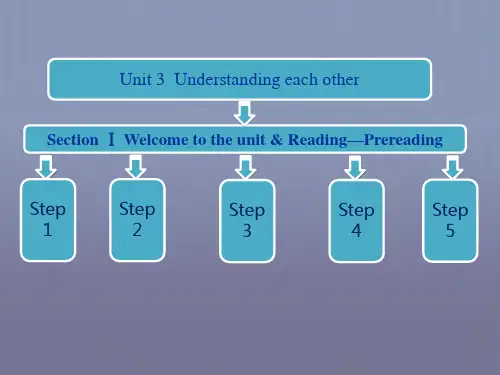
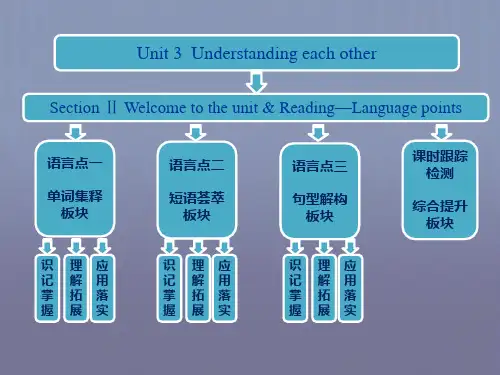

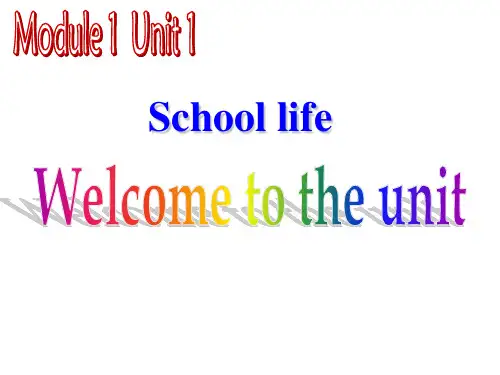
Module 6 Unit 3 Understanding each otherWelcome to the unit & Reading导学案〔两个课时〕学习目标:1. 阅读课本资料,了解一些国家不同的问候方式;2.通过图片资料以及阅读文本,进一步了解不同国家〔文莱、英国等〕在婚礼习俗、肢体语言、节日等方面的差异Part 1 Welcome to the unitStep 1 Lead-inHow do Chinese people greet each other in formal situations? Step 2 Picture-talkingDifferent ways of greeting in different countries Step 3Can you think of any other customs that are different in different parts of the world?Part A三个问题.)2. Thanksgiving)4. receiving presents )6. body language )8. wedding reception)10. taking off shoes before going inside a house Step 2 Careful readingWhat are the differences?1.2.3.4.5.6.Part 2 Reading Step 1 Fast reading1. 一轮阅读完成表层理解,完成 P342. 听录音,并选出课文提到的文化差异( )1. wedding ceremony ( ( )3. eye contact ( ( )5.food and clothes ( ( )7. festivals ( ()9. greeting(译林牛津版M6U3 导学案Module 6 Unit 3 Understanding each otherStep 3 SummaryPeople from different places or countries may be very different in some ways. Americans and Brits open a present they receive it. In Korea, people have a hen to ensuregood luck for the marriage, and a rooster to bad spirits from the wedding ceremony. When the hen lays an egg during the ceremony, everyone congratulates the new couple because it is considered very lucky. In Brunei, the men have to sit with the and thewomen the bride at wedding receptions. Food, soft drinks, tea and coffee are served, but alcohol is not. People in Brunei use their thumbs to point to avoid , so many foreigners have trouble getting to it. British people celebrate Bonfire Night on November 5th every year. People light large fires, let off outside, gather around andhas a party.When in Rome, do as the Romans do!Module 6 Unit 3 Understanding each other Word power 导学案〔一个课时〕学习目标1.了解并通过相关练习熟知英语外来词汇.2.学会一些跟动物或物品的特性有关的俗语.3.自主学习、合作探究.Part 1 Borrowed wordsStep1 Lead-inDo you know any English words borrowed from Chinese?Step 2 English borrowed from other languageI解决生词障碍〔可以参考P70〕1.geological terms3.Arabic __________________________5. ballet _____________________________7. colonel ___________________________n Read Part A & B, and fill in the blanks m学以致用,请完成P39 Part C 2. military ____________________________ 4. spice ______________________________ 6. confetti ______________________________ 8.opera _______________________________Part 2 Idioms connecting a characteristic with an animal or a thing.I Complete the sentences1.I didn ' t hear the telephone ringing. I.2.Emily never gets too excited about anything. She is always.3.Poor Richard spent his last penny on a bowl of noodles. Now he is.4.She never stops for a second. She is always.5.Don ' t worry. John will carry the box for you. He is. n More examples1.His hands are as black as coal.2.Without glasses she is as blind as a bat.3.The child is as bright as a button.4.Be careful of him. He as c unning as a fox.5.The twins are as like as two peas.6.The beautiful girl is as proud as a peacock.7.It ' s impossible to persuade him. Hes stubborn as sa mule.8.You can ' t expect her to do that. Sas timid as a mouse.in Complete the passageas white as snow as hungry as a lionas mad as a wet hen as proud as a peacockSnow WhiteLong long ago, there was a princess with skin, so people called her Snow White. Her stepmother was, but had a heart of stone. Hearing that Snow White became far more beautiful than her, she got and wanted to kill the girl.Snow White escaped from the house, and was lost in the forest. She was.Module 6 Unit 3 Understanding each otherGrammar and usage Unreal conditions导学案〔一个课时〕学习目标1.通过语篇初步了解if非真实条件句.2.通过配套练习,灵活的运用if非真实条件句.3.掌握if非真实条件句的省略与倒装.4.自主学习、合作探究,学以致用!Part 1 Lead-inAs is known to all, different countries have different cultures. If you asked whether a British man had eaten or not, he would be shocked. What interests us most is that there are sometimes great cultural differences even between native English speakers. If you were to visit Britain on November 5th, you would experience Bonfire Night, which Americans are not familiar with at all.If Ma Li had read more books about cultural differences before, she would have had no trouble with her homework.1.请大家认真阅读第40页的导读内容,并且答复:What is an unreal conditional?2.词汇expectation embarrassingemperor business consultantget into trouble let alonePart 2 Unreal conditionsI if非真实条件句在不同时态中的使用1.Unreal present tense.If you asked whether a British man had eaten or not, he would be shocked. If he were here, he Array might be able to help us.Practice:1)If I(be) a bit taller, I(reach) the box. (P40)2)If I(have) the chance, I(want) to be a business consultant. (P40)3)If God(give) me another chance, I(say) the three words to her--- I love you.2. __________________________If Ma Li had read more books about cultural differences before, she would have had no trouble with her homework.Practice 1:请用if非真实条件句改写以下句子:1)I was nervous just now, so I didn ' t score.2)I didn ' t do exercise before, so I was fat.3)I came late, so I didn ' t see Jay.Practice 2:选择正确答案1)If you the chat room ten minutes ago, you would have known what we were talking about!(P40)A.joinedB. have joinedC. had joinedD. joins2)If the man had pointed with his first finger when he was in Brunei, everyonethat he was very rude.(P40)A.will thinkB. would thinkC. will have thoughtD. would have thought3)If life so hard for me as a child, I working at such a young age.(P116 C1)A.had not been; would not have startedB. was; would not have startedC. had been; would have startedD. was not; would start3.Unreal future conditionsIf you were to visit Britain on November 5th, you would experience Bonfire Night, which Americans are not familiar with at all.If I had time tomorrow, I would certainly help you.Practice: Make up your own sentences(合作探究,2 分钟)1)If it should be the doomsday(世界末日)tomorrow, what would you do?2)What would you do, if it were to be June 6, 2021 tomorrow?If you(tell) me earlier, I(not get) into trouble.(P41)If I(be) taller, I(be) better at basketball.(P116C1).If you(take) the train, you(get) there much sooner.(P41)Practice:阅读41页的文章,用if虚拟条件句改写句子.模块六三单元Module 6 Unit3 Understanding each otherTask导学案〔一个课时〕学习目标1.输入信息:阅读一篇关于国外禁忌的文章,了解不同文化背景的传统差异.听两段P42、P43的听力练习,让学生在亲身体验中感受不同的文化,传统和禁忌.输出信息:写一封抱歉信, 解释文化上的误会.2.学习听力技巧:如何做好听力填空题3.自主学习、合作探究.Part 1 Listening and reading1.阅读42页的导入局部,并且完成:Before the listening:Read the text to and you are likely to hear.Decide if it is or.After the listening:Check and.2.听录音,补全42页内容3.What are the incidents mentioned in the article?5.Listen to Part C and get more information about cultural differences.Consolidation Taboos in India, Japan, AmericaIndia:Japan:America:Part 2 Writing a letter of apology1.How to write your letter?(P45)2.结合42、43 页所学的内容,在Mr Singh(Indian), Mr Takashi(Japanese),与Mr Hudson(American)三个人中选择一个人写一封抱歉信.模块六三单元Module 6 Unit 3 Understanding each otherProject Making a reference book导学案(一个课时)学习目标1.通过阅读文化体验之旅旅游公司旅游小册,了解四种少数民族文化---因纽特,澳大利亚土著,新西兰毛利,美洲印第安土著2.学以致用,呈现家乡传统,风俗,生活方式特色一面.Part 1 Read and get some basic information about the four minorities.Part 2 n Reading comprehension1.After reading this travel brochure, you have some ideas about.A. different minority culturesB. different ethnic traditionsC. unique customs and lifestylesD. all of the above2.Which of the following is NOT true according to the text?A.While dancing with the Inuit people, you may be invited to wear a special animal dance mask carved from wood.B.The Maori people are believed to be originally from the Pacific islands of Polynesia.C.American Indians live in wooden houses and wear clothes made from animal skins.D.Aborigines have developed a piece of wood as a tool for hunting, which is called boomerang.3.Your friend likes travelling and is interested in sleeping in tents. He is especially fond ofhunting animals with bows and arrows. Which place do you suggest he visit?A.Nunavut in Canada where the Inuit live.B.The Pacific Island of Polynesia where Maoris liveC.Kakado in Australia where Aborigines live.D.The centre of North America where the Plains Indians live.4.Which of the following can be inferred from the text?A.The Aborigines live mainly in meat and still live by gathering food.B.Gods and Spirits played and are still playing an important part in these ethnic groups ives.C.The Inuit people like to hunt food with bows and arrowsD.The Maori people like to pay their respect to Gods by singing and dancing.Part 3 Sentence imitatingSentence bank 1: to describe history and famous peopleSentence imitating:Xiangxiang the " Dragon City 〞 ,legends.Xiangxiang Chu during the Spring and Autumn period and the Warring StatesPeriod. It many famous people, such as Huang gonglue, Tanzheng, Chenggen, Xiaosan,Cai hesen and so on. Xiangxiang accent is an oldest language, which is also most difficult to understand.Sentence bank 2: to describe foodSentence bank 3: to describe beliefSentence bank 4: to describe way of lifeSentence imitating:1.湘乡的人们参加很多锻炼.2.你会看到人们爬东台山.并且在被打造成沿河风光带的滨河路上散步。